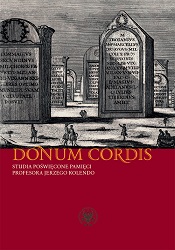Mitrydates i święty Jerzy, czyli echa antyku na kwartniku śląskim
Mithridates and St George, or the echoes of antiquity on a Silesian kwartnik
Author(s): Borys Paszkiewicz
Subject(s): Archaeology
Published by: Wydawnictwa Uniwersytetu Warszawskiego
Keywords: Jerzy Kolendo; archaeology; Poland; Europe; University of Warsaw; Polish Academy of Sciences
Summary/Abstract: In the years 2012–2016 three specimens of an unknown type of kwartnik have been discovered, showinga head profi le on the obverse and on the reverse a fi gure of a nimbate knight holding a sword and a shieldwith a cross. Next to the fi gure the letters “C S” are written (Figs 1–3). The head profi le appears in three knowntypes of kwartniks from Wielkopolska, but on each of them it is depicted in a completely different style (Figs 4–6).The reverse has close analogies in three kwartniks: two of uncertain origins, one from a mint in Krosno in LowerSilesia. However, the attributes held by the standing knight are different in that case. The iconographic modelhere is derived from Brandenburg coinage but was also used in Wielkopolska.Despite the low quality of the die impressions of all the three coins, it is clear that the portrait die was perfectlymade. It is so different from the binding convention of the early 14th century that it must be patterned afteran ancient specimen. We consider the tetradrachm of Mithridates VI Eupator, the king of Pontus (120–63 BC) tobe the most similar one (Fig. 7). Although these coins do not appear in Poland, some have been found in the territoriesof south Ukraine which were linked to Poland in the 14th century through trading contacts. This directreference to Hellenistic coinage is an exception in European minting of the 14th century.The head on the kwartnik represents the ruler – the one issuing the coin. The nimbate man could be St Georgeor St Maurice. Both saints are very rarely patrons of Polish churches. The coin was probably minted in one ofthe centres of power of the dukes of north Silesia and Wielkopolska in the beginning of the 14th century. Kłeckowould be the most likely place, as it was the capital of the district in the times of the ruling of the dukes ofGłogów in Wielkopolska and its parish church was dedicated to St George. The letters “C S” could stand forC[onradus dux] S[lezie], referring to Conrad I, the Duke of Namysłów and east Wielkopolska in the years 1312–1313.Kłecko was completely destroyed in 1331 by a Teutonic raid and remained a small town, but at the turn of the13th and 14th centuries it had been one of the most important urban centres of Wielkopolska. During the discussion,Mr Krzysztof Górny suggested an alternative solution. There was a mint of the dukes of Głogów in Ścinawawhich was evidenced many times at the turn of the 13th and 14th centuries. Moneyer Conrad was the mayorof this town in 1310, and the old parish church there was dedicated to St George, hence the letters “C S” wouldmean Conradus – Stinavia. The attribution of this kwartnik to Ścinawa is also supported by the distribution offi nds (near Świebodzin and near Krosno Odrzańskie). This solution is more plausible.Even if both presented hypotheses turn out to be incorrect, the evident reference to Hellenistic coinage willremain a surprising supplement to the studies on the knowledge of ancient coins in historical Poland conductedby Jerzy Kolendo and his students.
Book: Donum cordis. Studia poświęcone pamięci Profesora Jerzego Kolendo
- Page Range: 290-301
- Page Count: 11
- Publication Year: 2019
- Language: English, Polish, German
- Content File-PDF

